牛津译林版(2019)选择性必修 第一册Unit 3 The art of painting Integrated skills 课件(共40张PPT)
文档属性
| 名称 | 牛津译林版(2019)选择性必修 第一册Unit 3 The art of painting Integrated skills 课件(共40张PPT) | 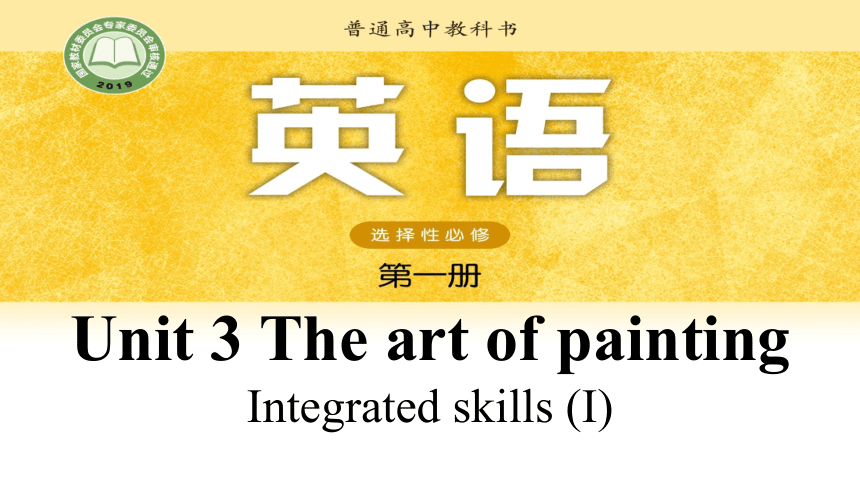 | |
| 格式 | pptx | ||
| 文件大小 | 95.4MB | ||
| 资源类型 | 教案 | ||
| 版本资源 | 牛津译林版(2019) | ||
| 科目 | 英语 | ||
| 更新时间 | 2023-09-02 20:07:41 | ||
图片预览

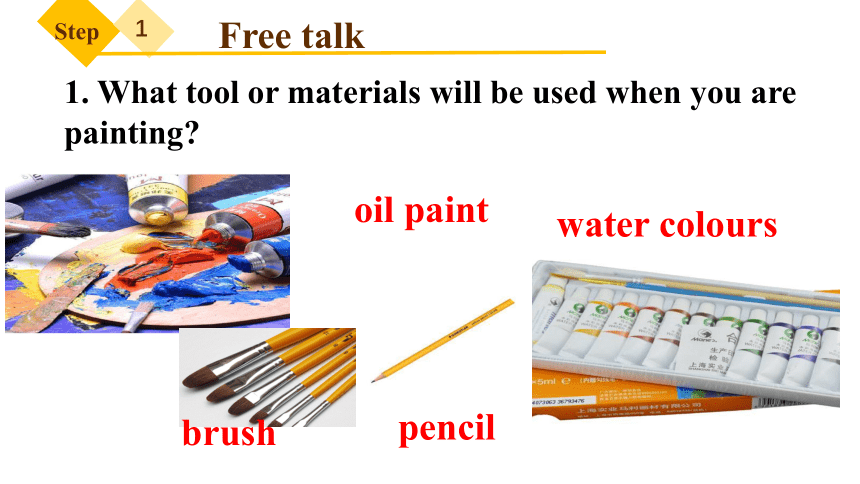
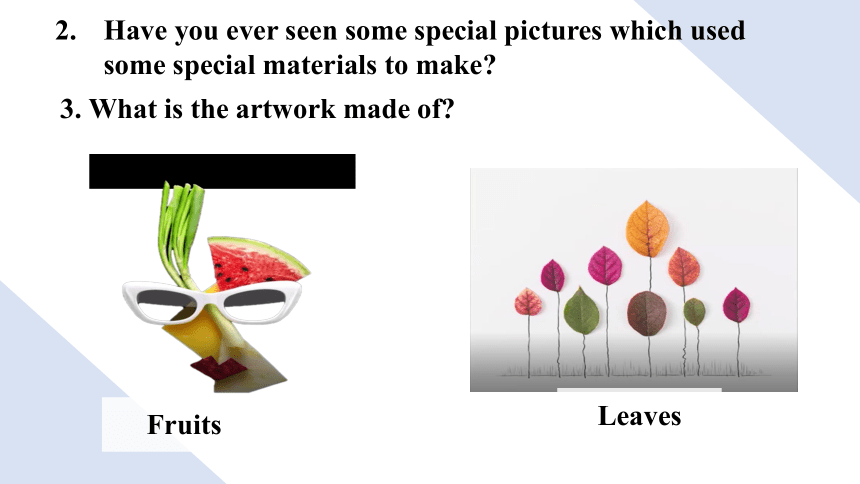
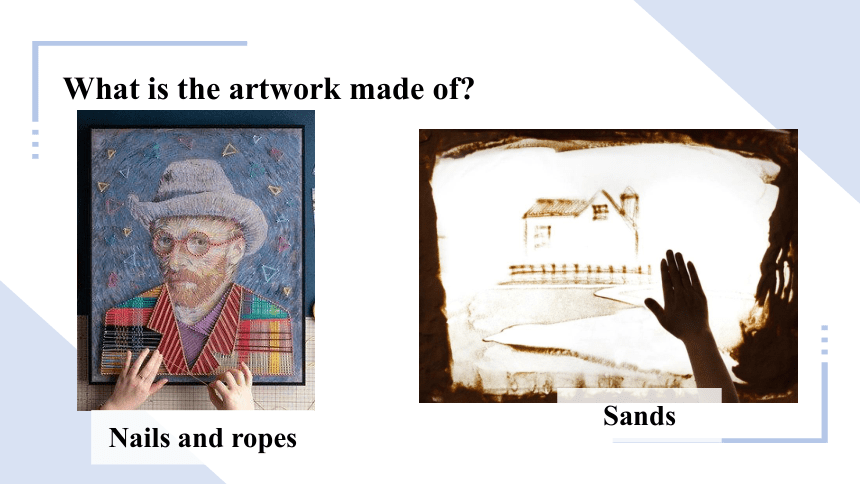
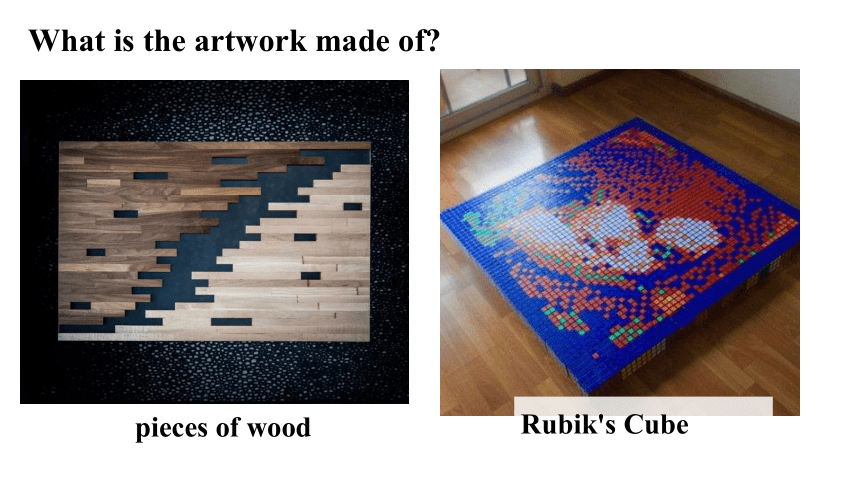
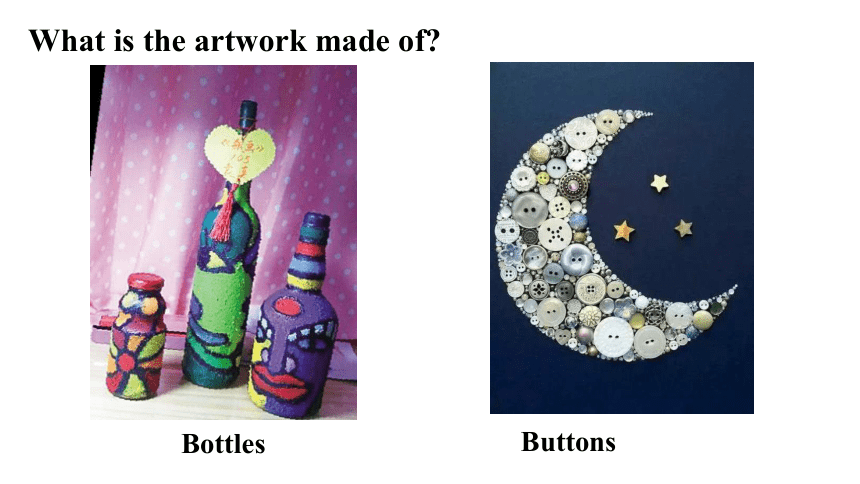
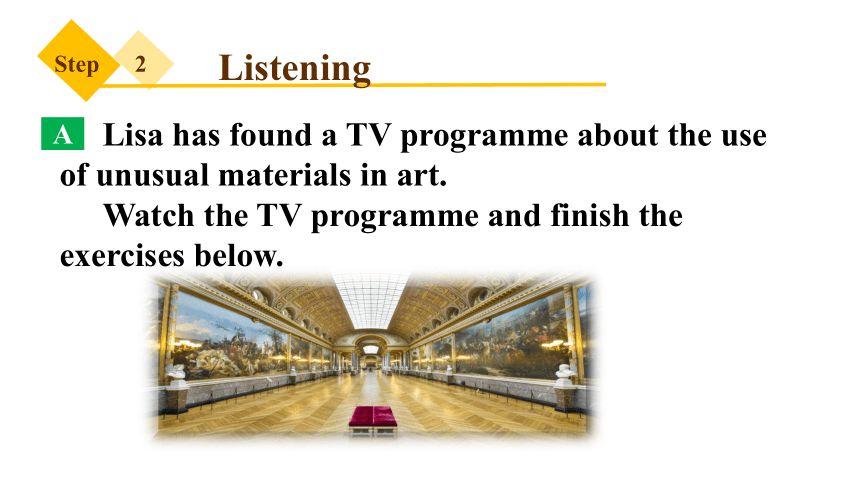
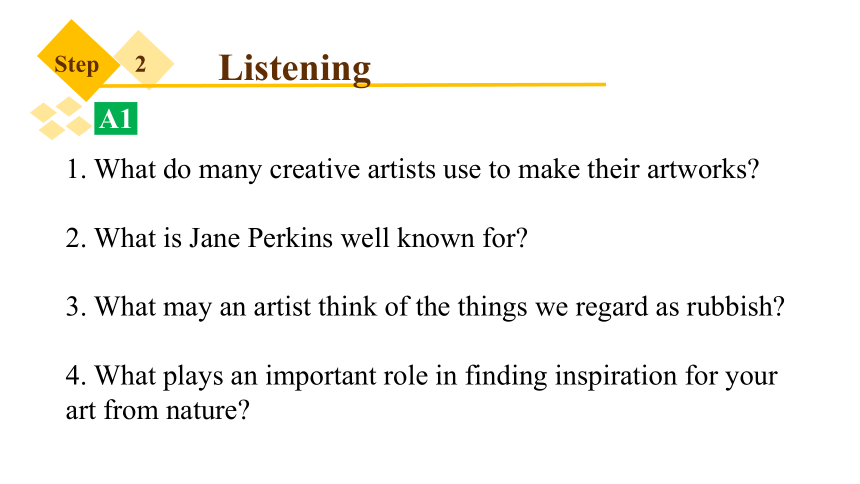
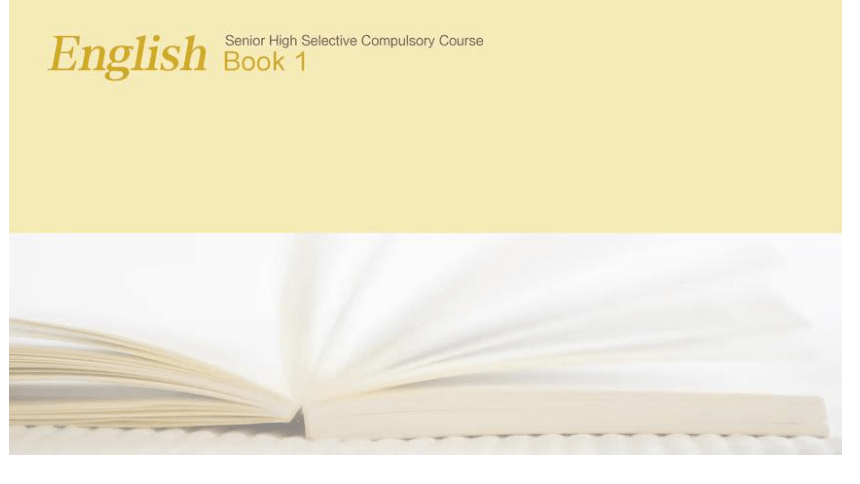
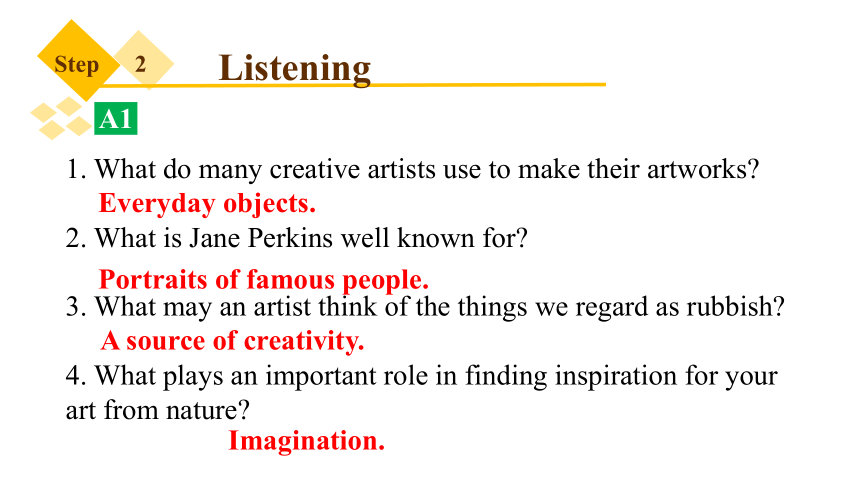
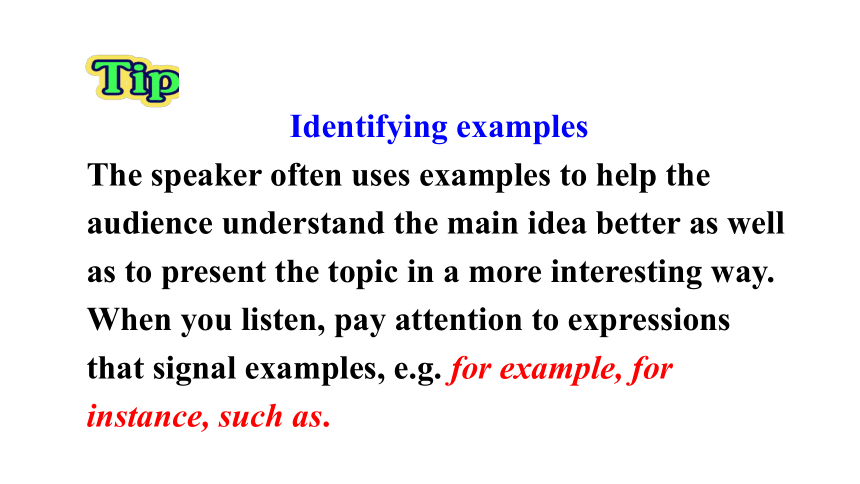
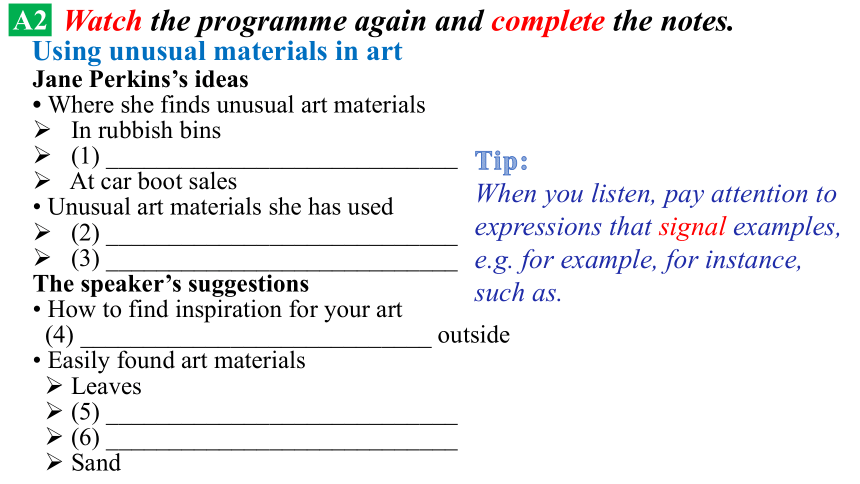
文档简介
(共40张PPT)
Unit 3 The art of painting
Integrated skills (I)
1
Step
Free talk
1. What tool or materials will be used when you are painting
oil paint
water colours
pencil
brush
Have you ever seen some special pictures which used some special materials to make
Fruits
Leaves
3. What is the artwork made of
Sands
What is the artwork made of
Nails and ropes
pieces of wood
Rubik's Cube
What is the artwork made of
Bottles
Buttons
What is the artwork made of
2
Step
Listening
Lisa has found a TV programme about the use of unusual materials in art.
Watch the TV programme and finish the exercises below.
A
2
Step
Listening
1. What do many creative artists use to make their artworks
2. What is Jane Perkins well known for
3. What may an artist think of the things we regard as rubbish
4. What plays an important role in finding inspiration for your art from nature
A1
2
Step
Listening
1. What do many creative artists use to make their artworks
2. What is Jane Perkins well known for
3. What may an artist think of the things we regard as rubbish
4. What plays an important role in finding inspiration for your art from nature
Everyday objects.
Portraits of famous people.
A source of creativity.
Imagination.
A1
Identifying examples
The speaker often uses examples to help the audience understand the main idea better as well as to present the topic in a more interesting way. When you listen, pay attention to expressions that signal examples, e.g. for example, for instance, such as.
Jane Perkins’s ideas
Where she finds unusual art materials
In rubbish bins
(1) ____________________________
At car boot sales
Unusual art materials she has used
(2) ____________________________
(3) ____________________________
The speaker’s suggestions
How to find inspiration for your art
(4) ____________________________ outside
Easily found art materials
Leaves
(5) ____________________________
(6) ____________________________
Sand
Watch the programme again and complete the notes.
Using unusual materials in art
Tip:
When you listen, pay attention to expressions that signal examples, e.g. for example, for instance, such as.
A2
Jane Perkins’s ideas
Where she finds unusual art materials
In rubbish bins
(1) ____________________________
At car boot sales
Unusual art materials she has used
(2) ____________________________
(3) ____________________________
The speaker’s suggestions
How to find inspiration for your art
(4) ____________________________ outside
Easily found art materials
Leaves
(5) ____________________________
(6) ____________________________
Sand
Watch the programme again and complete the notes.
Using unusual materials in art
At recycling centres
Old buttons
Small toys
Take a walk
Grass
Small stones
Tip:
When you listen, pay attention to expressions that signal examples, e.g. for example, for instance, such as.
A2
2
Step
Listening
Post-listening
After listening, can you tell me what unusual materials are mentioned in the video
Unusual art materials
Materials mentioned in the video
More materials
Old buttons
Small toys
Grass
Small stones
Leaves
Sand
old clothes
plastic bottles
old batteries
old shoes
...
Can you make an unusual picture with unusual materials
What can we do with these waste materials
portrait painting
plastic fork
buttons
What can we do with these waste materials
coffee grounds咖啡渣
fallen leaves
leaves painting
Aim:Giving instructions for making an unusual picture
Materials&Tools
Use verbs to describe each step.
Steps
Use conjunction to connect each step.
Conjunction
Waste materials and
natural materials
glue
scissors
paint and brush
Key point 1: Tools
strings
paperboard
napkin
What tools and materials did you use?
Key point 1::Materials
plastic bottle
cotton
Read and find verbs on P37:
Key point 2: Steps(verbs)
1. 用...来制作...______________
2. ...被用来制作...____________
3. 把...平放在桌上_____________
4. 把...整理好放在...上________________
5.把...粘在...上__________________
Fill in verbs on steps:
make...out of
be used to do...
lay...out on the table
arrange...on...
stick...to...
More verbs :
fold_______________ press______________
pinch _____________
折叠
压
捏
How can you connect each step
1. first/firstly/ first of all/to begin with/ to start with
2. secondly/It’s followed by.../ the next step is...
3. in the meantime, at the same time,once, as soon as
4. lastly, at last, finally, in the end
Key point 3: Conjunctions
Exercise: watch and retell
Exercise:
1.Tools&Materials:
2. Steps with conjunctions:
_________, _________, ________ , __________, _______
paper
paint
pencil
scissors
glue
______________, ________ some _________to the paper.
The next step is to ________
the paper.
At the same time, _______
the wings with a ________.
Then ________
the wings with_________.
_____________,_________the body with
____________
add
paint
First of all
fold
draw
pencil
cut
scissors
Lastly
stick
glue
How to give an instruction
1. Name of your masterpiece.
2. Tools&Materials used.
(e.g.The materials used in our artwork are...)
3. Each steps(verbs: fold, stick, arrange, lay out...)
4. Conjunctions(firstly, the next step is, at last...)
Group discussion:
Show yourself!
Giving instructions for making an unusual picture
Group 1
Group 2
Group 3
Group 4
Group 5
Group 6
scissors/ paper/glue/paint/plastic bottle
Summary: How to give an instruction
Tools&Materials
Steps(verbs)
fold/press/create/ stick/pinch/ select/arrange/ lay out
Conjunction
1.first/firstly/ first of all/to begin with/ to start with
2. secondly/It’s followed by.../ the next step is...
3. at the same time, in the mean time, as soon as,
4. lastly, at last, finally, in the end
Let’s save the world with creativity!
1.Polish your steps.
2.Writing task: How to make an unusual picture (name+reasons+tools&materials+steps).
Homework:
Thank You For Listening Goodbye
Unit 3 The art of painting
Integrated skills (I)
1
Step
Free talk
1. What tool or materials will be used when you are painting
oil paint
water colours
pencil
brush
Have you ever seen some special pictures which used some special materials to make
Fruits
Leaves
3. What is the artwork made of
Sands
What is the artwork made of
Nails and ropes
pieces of wood
Rubik's Cube
What is the artwork made of
Bottles
Buttons
What is the artwork made of
2
Step
Listening
Lisa has found a TV programme about the use of unusual materials in art.
Watch the TV programme and finish the exercises below.
A
2
Step
Listening
1. What do many creative artists use to make their artworks
2. What is Jane Perkins well known for
3. What may an artist think of the things we regard as rubbish
4. What plays an important role in finding inspiration for your art from nature
A1
2
Step
Listening
1. What do many creative artists use to make their artworks
2. What is Jane Perkins well known for
3. What may an artist think of the things we regard as rubbish
4. What plays an important role in finding inspiration for your art from nature
Everyday objects.
Portraits of famous people.
A source of creativity.
Imagination.
A1
Identifying examples
The speaker often uses examples to help the audience understand the main idea better as well as to present the topic in a more interesting way. When you listen, pay attention to expressions that signal examples, e.g. for example, for instance, such as.
Jane Perkins’s ideas
Where she finds unusual art materials
In rubbish bins
(1) ____________________________
At car boot sales
Unusual art materials she has used
(2) ____________________________
(3) ____________________________
The speaker’s suggestions
How to find inspiration for your art
(4) ____________________________ outside
Easily found art materials
Leaves
(5) ____________________________
(6) ____________________________
Sand
Watch the programme again and complete the notes.
Using unusual materials in art
Tip:
When you listen, pay attention to expressions that signal examples, e.g. for example, for instance, such as.
A2
Jane Perkins’s ideas
Where she finds unusual art materials
In rubbish bins
(1) ____________________________
At car boot sales
Unusual art materials she has used
(2) ____________________________
(3) ____________________________
The speaker’s suggestions
How to find inspiration for your art
(4) ____________________________ outside
Easily found art materials
Leaves
(5) ____________________________
(6) ____________________________
Sand
Watch the programme again and complete the notes.
Using unusual materials in art
At recycling centres
Old buttons
Small toys
Take a walk
Grass
Small stones
Tip:
When you listen, pay attention to expressions that signal examples, e.g. for example, for instance, such as.
A2
2
Step
Listening
Post-listening
After listening, can you tell me what unusual materials are mentioned in the video
Unusual art materials
Materials mentioned in the video
More materials
Old buttons
Small toys
Grass
Small stones
Leaves
Sand
old clothes
plastic bottles
old batteries
old shoes
...
Can you make an unusual picture with unusual materials
What can we do with these waste materials
portrait painting
plastic fork
buttons
What can we do with these waste materials
coffee grounds咖啡渣
fallen leaves
leaves painting
Aim:Giving instructions for making an unusual picture
Materials&Tools
Use verbs to describe each step.
Steps
Use conjunction to connect each step.
Conjunction
Waste materials and
natural materials
glue
scissors
paint and brush
Key point 1: Tools
strings
paperboard
napkin
What tools and materials did you use?
Key point 1::Materials
plastic bottle
cotton
Read and find verbs on P37:
Key point 2: Steps(verbs)
1. 用...来制作...______________
2. ...被用来制作...____________
3. 把...平放在桌上_____________
4. 把...整理好放在...上________________
5.把...粘在...上__________________
Fill in verbs on steps:
make...out of
be used to do...
lay...out on the table
arrange...on...
stick...to...
More verbs :
fold_______________ press______________
pinch _____________
折叠
压
捏
How can you connect each step
1. first/firstly/ first of all/to begin with/ to start with
2. secondly/It’s followed by.../ the next step is...
3. in the meantime, at the same time,once, as soon as
4. lastly, at last, finally, in the end
Key point 3: Conjunctions
Exercise: watch and retell
Exercise:
1.Tools&Materials:
2. Steps with conjunctions:
_________, _________, ________ , __________, _______
paper
paint
pencil
scissors
glue
______________, ________ some _________to the paper.
The next step is to ________
the paper.
At the same time, _______
the wings with a ________.
Then ________
the wings with_________.
_____________,_________the body with
____________
add
paint
First of all
fold
draw
pencil
cut
scissors
Lastly
stick
glue
How to give an instruction
1. Name of your masterpiece.
2. Tools&Materials used.
(e.g.The materials used in our artwork are...)
3. Each steps(verbs: fold, stick, arrange, lay out...)
4. Conjunctions(firstly, the next step is, at last...)
Group discussion:
Show yourself!
Giving instructions for making an unusual picture
Group 1
Group 2
Group 3
Group 4
Group 5
Group 6
scissors/ paper/glue/paint/plastic bottle
Summary: How to give an instruction
Tools&Materials
Steps(verbs)
fold/press/create/ stick/pinch/ select/arrange/ lay out
Conjunction
1.first/firstly/ first of all/to begin with/ to start with
2. secondly/It’s followed by.../ the next step is...
3. at the same time, in the mean time, as soon as,
4. lastly, at last, finally, in the end
Let’s save the world with creativity!
1.Polish your steps.
2.Writing task: How to make an unusual picture (name+reasons+tools&materials+steps).
Homework:
Thank You For Listening Goodbye
同课章节目录
- Unit 1 Food matters
- Welcome to the unit
- Reading
- Grammar and usage
- Integrated skills
- Extended reading
- Project
- Unit 2 The Universal Language
- Welcome to the unit
- Reading
- Grammar and usage
- Integrated skills
- Extended reading
- Project
- Unit 3 The art of painting
- Welcome to the unit
- Reading
- Grammar and usage
- Integrated skills
- Extended reading
- Project
- Unit 4 Exploring poetry
- Welcome to the unit
- Reading
- Grammar and usage
- Integrated skills
- Extended reading
- Project
